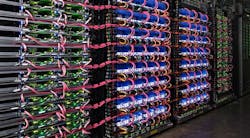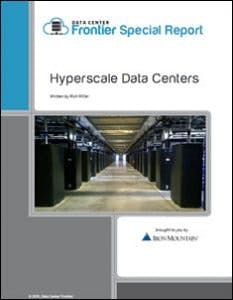Data Center Frontier continues to explore strategic data center markets and niches via our DCF Special Reports. We have partnered with Iron Mountain to explore the hyperscale data center market, and how its growth has changed how we compute. This excerpt from a recent Hyperscale Data Center report explores the future of hyperscale computing.
Download the full report.
The hyperscale data center has become the form factor for a new paradigm for delivering IT services. It is reshaping the global infrastructure for data centers and cloud computing platforms, and disrupting the business of how IT space is bought, built and provisioned. More change lies ahead.
At Data Center Frontier, we believe the next 10 to 15 years will be an era of continuous advancement, as next-generation technologies accelerate the digitization of the global economy.
This period will be marked by two overarching themes:
- Innovation on the front end, as technology companies and service providers race to deploy and commercialize new technologies like AI, the Internet of Things, augmented reality, 5G wireless and autonomous vehicles.
- Industrialization on the back end, as new investment streamlines the global supply chain, bringing new levels of speed and efficiency to the delivery of hyperscale capacity.
There will be business opportunities driven by scale, and others driven by specialization. Here are some of the trends we see:
Massive cloud campuses will be supported by subsea cables, cable landing stations, network nodes, and edge data centers extensions, all of which become part of the strategic conversation for hyperscale computing.
New money, new players
Some of the world’s largest investors are raising billions of dollars to invest in digital infrastructure, citing extraordinary demand for capital to fuel the shift to a data economy. Infrastructure funds and sovereign wealth funds are creating new companies and investing in data center construction. These investors have been key players in the formation of STACK Infrastructure, EdgeCore Internet Real Estate and Evoque Data Center Solutions, and have brought fresh capital and energy to Vantage Data Centers, Cologix, Aligned Energy and T5 Data Centers.
Hyperscale providers are seeking to position data center capacity to serve growing audiences in Europe, Asia, South America and even Africa. (Photo: Google)
Segmentation and Differentiation
As the data center industry becomes more competitive, both new players and incumbents will seek ways to differentiate and win hyperscale business. Cost of capital will be a major differentiator, and in some markets this will mean pressure on pricing. But providers will also have opportunities to create distinctive offerings in areas beyond cost and speed, including renewable procurement capabilities, on-site generation, earthquake and disaster protection, and interconnection and network services
It’s a Global Game
Hyperscale operators have global ambitions, and data center providers are racing to establish expertise and footprints in Europe, the Asia-Pacific region, South America and Africa. The ability to operate in any market will be a critical strategy for both hyperscalers and their providers.
Connective Tissue for the Global Network
Also important, but not as well understood, is the ability to help hyperscalers tie together their global operations and networks. Massive cloud campuses will be supported by subsea cables, cable landing stations, network nodes, and edge data centers, all of which become part of the strategic conversation for hyperscale computing.
Edge Will Evolve Slowly, Then Accelerate
Edge computing promises to extend data processing and storage, moving it closer to the growing universe of devices and sensors at the edge of the network. Edge computing is evolving in tiers, with opportunities in regional data hubs, small sites at telecom towers and on devices. At DCF we think of it in terms of “edge, edgier and edgiest.”
These distinctions are still evolving, and are being closely tracked by hyperscale companies and data center providers. Many have already deployed meaningful edge networks, and others are seeking to clarify their strategies for emerging opportunities in edge computing. Companies are deciding where they’re going to play, and when the business will arrive. Just as there are many edges, there are many ways to compete and capture business.
M&A Activity Will Accelerate
As edge computing, 5G and autonomous technologies evolve, we’ll see a very active merger and acquisition environment featuring the hyperscale operators and the providers who support them. Some of these deals will be strategic, as key players add new capabilities to target promising niches. Some deals will be guided by geography and interest in new markets. Some deals will be opportunistic, particularly for early movers whose capital and deal flow fail to keep pace with their roadmaps and aspirations.
At DCF, we believe many players are skeptical about the timing of demand from edge computing and 5G, and may need to play “catch up” when the business materializes. M&A is the best way to accomplish this.
More Liquid Cooling
We’ve been tracking progress in rack density and liquid adoption for years at Data Center Frontier as part of our focus on new technologies and how they may transform the data center. The rise of artificial intelligence, and the hardware that often supports it, is reshaping the data center industry’s relationship with servers. New hardware for AI workloads is packing more computing power into each piece of equipment, boosting the power density – the amount of electricity used by servers and storage in a rack or cabinet – and the accompanying heat. New silicon offerings from hardware startups could bring even denser workloads into the data center.
Google’s decision to shift to liquid cooling with its latest hardware for artificial intelligence raised expectations that others might follow. Alibaba and other Chinese hyperscale companies have adopted liquid cooling, and Microsoft recently indicated that it has been experimenting with liquid cooling for its Azure cloud service. It’s not yet clear how widely hyperscale players will embrace liquid cooling, but more powerful computing hardware suggest that broader adoption is inevitable that these companies will use liquid cooling for some AI workloads, while continuing to use air for traditional cloud and enterprise computing.
Moonshots with Game-Changing Potential
Hyperscale operators have been consistent innovators, have active R&D operations, and are not afraid to try radical new approaches. An example is Project Natick, Microsoft’s underwater data center program, which runs servers on the ocean floor. “Since 50 percent of the world’s population lives close to bodies of water, we think this is the way we want to think about the future of data center regions and expansion,” said Microsoft CEO Satya Nadella.
Is Project Natick just a science experiment? If it succeeds, who will help Microsoft build this type of infrastructure? Watch this space. We suspect we will see other potentially game-changing projects emerge from hyperscale R&D labs.
One Thing is Certain
Relationships and experience will be more important than ever. Hyperscale operators want dependability in delivery, and consistency in design and performance. They are increasingly seeking partners rather than just vendors.
This special report series also covered the following topics. Catch up on the series below:
- Reshaping the Global IT Landscape: The Impact of Hyperscale Data Centers
- Who are the Data Center’s Industry’s Hyperscale Players?
- How Hyperscale Customers & Data Centers are Unique
- Hyperscale Computing Poised to Make Dramatic Impact on Service Providers
Download the full report, “Hyperscale Data Centers,” courtesy of Iron Mountain Data Centers, to learn more about how hyperscale computing has changed the supply chain for digital infrastructure, and how this computing shift will evolve.
About the Author




